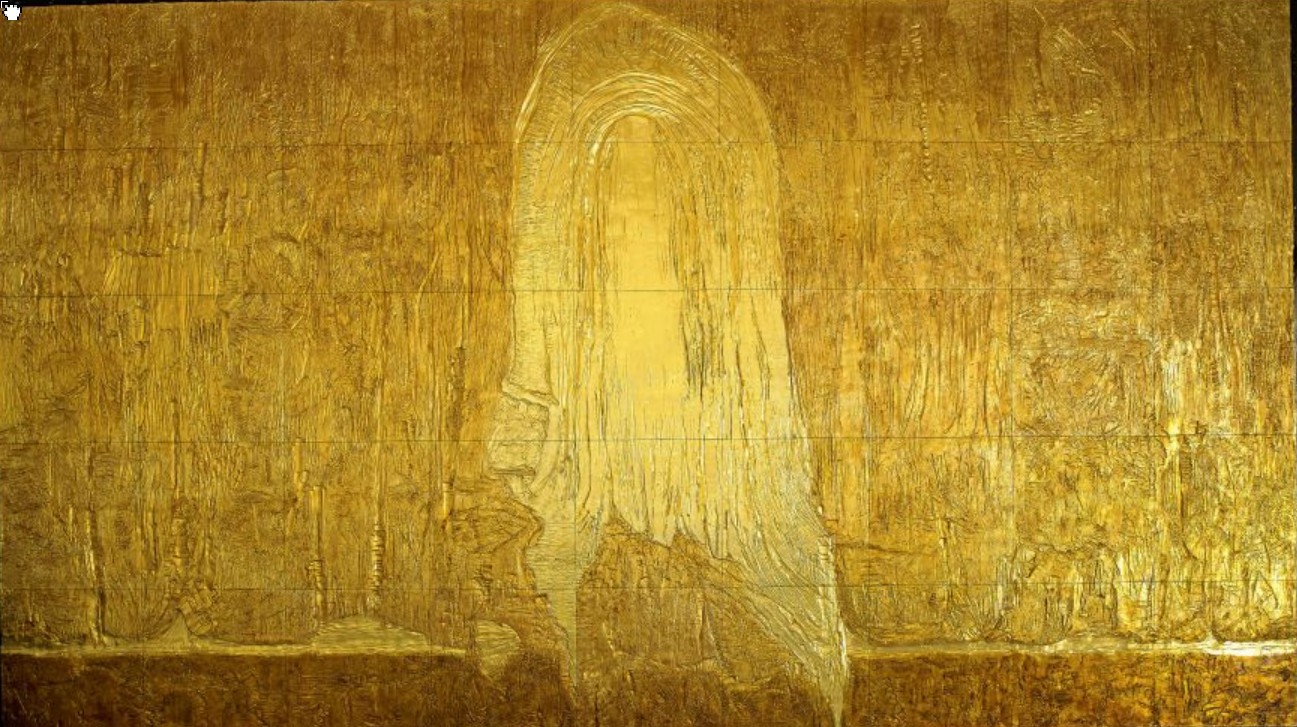 There is a new and very large work of sacred art at Biola University. It is a wall-sized relief sculpture inside the newly-renovated Calvary Chapel, and it depicts the resurrection. Or perhaps it doesn’t quite “depict” the resurrection. It depicts the empty tomb, but it does so in three tones of gold (dark, light, and smooth-polished) and through a screen of abstraction so sovereign that plenty of viewers think they may be confronting a giant head or face instead of a cavern.
There is a new and very large work of sacred art at Biola University. It is a wall-sized relief sculpture inside the newly-renovated Calvary Chapel, and it depicts the resurrection. Or perhaps it doesn’t quite “depict” the resurrection. It depicts the empty tomb, but it does so in three tones of gold (dark, light, and smooth-polished) and through a screen of abstraction so sovereign that plenty of viewers think they may be confronting a giant head or face instead of a cavern.
And “wall-sized relief sculpture” isn’t quite the right thing to call it, either. It just is the wall; the entire surface of the wall, all the way to the corners. What people inside the chapel see is a solid wall made up of 45 panels (arranged nine long by five tall). And it’s golden.
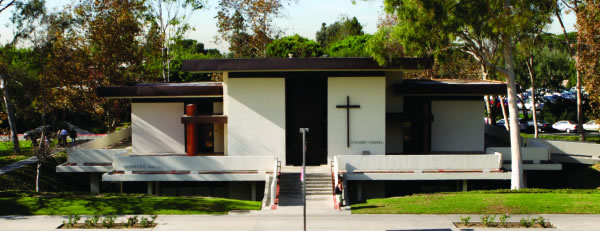 This resurrection wall is the northwest interior wall of the newly renovated Calvary Chapel. That altar or pulpit location would be the eastern wall in a building that followed the canons of traditional Christian architecture, but Biola’s Calvary Chapel is very much a mid-century California piece of work whose long, flat lines follow other rules. The 1975 building, by architect John Gougeon, has always struck me as a sanctified split-level ranch-style rambler. Biola is surrounded by the thousand humble mini-ranch houses of La Mirada, and in that context the architecture of Calvary Chapel seems like the glorification and consecration of their lines and planes. It stands over against the university library across the quad (see this article by Paul Rood for the origin of the chapel, and its subterranean Feinberg Hall), midcentury modernist but not extreme. It’s not huge. It has no swooping lines or curvy extravagances; it’s Gougeon architecture, but it’s not Googie architecture.
This resurrection wall is the northwest interior wall of the newly renovated Calvary Chapel. That altar or pulpit location would be the eastern wall in a building that followed the canons of traditional Christian architecture, but Biola’s Calvary Chapel is very much a mid-century California piece of work whose long, flat lines follow other rules. The 1975 building, by architect John Gougeon, has always struck me as a sanctified split-level ranch-style rambler. Biola is surrounded by the thousand humble mini-ranch houses of La Mirada, and in that context the architecture of Calvary Chapel seems like the glorification and consecration of their lines and planes. It stands over against the university library across the quad (see this article by Paul Rood for the origin of the chapel, and its subterranean Feinberg Hall), midcentury modernist but not extreme. It’s not huge. It has no swooping lines or curvy extravagances; it’s Gougeon architecture, but it’s not Googie architecture.
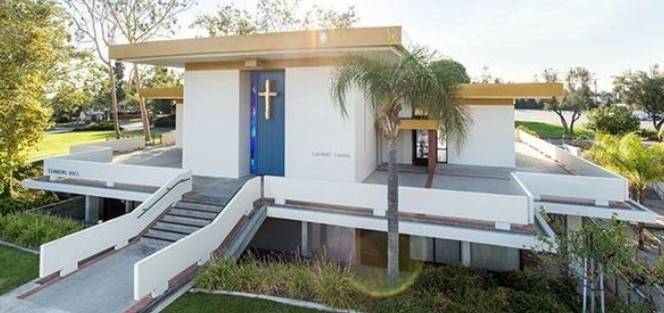 And this is the building that the resurrection wall is designed to fit into, as part of the ambitious renovation that the chapel has undergone this summer. The entire project is by two accomplished Danish artists, Peter Brandes and Maja Lisa Engelhardt, who happen to be married but have not, until now, collaborated on a work of public art. There is much to admire in the renovations, from the clarification of the building’s exterior lines to its complex iconographic program carried out in a suite of 32 stained glass windows positioned all around the chapel, innovatively lighted. It is Brandes’ windows that offer themselves most immediately for meditation and interpretation, because many of them feature human figures in recognizable biblical characters and scenes. And also because we expect to see stained glass windows in chapels.
And this is the building that the resurrection wall is designed to fit into, as part of the ambitious renovation that the chapel has undergone this summer. The entire project is by two accomplished Danish artists, Peter Brandes and Maja Lisa Engelhardt, who happen to be married but have not, until now, collaborated on a work of public art. There is much to admire in the renovations, from the clarification of the building’s exterior lines to its complex iconographic program carried out in a suite of 32 stained glass windows positioned all around the chapel, innovatively lighted. It is Brandes’ windows that offer themselves most immediately for meditation and interpretation, because many of them feature human figures in recognizable biblical characters and scenes. And also because we expect to see stained glass windows in chapels.
But it’s Engelhardt’s monumental golden wall, which we do not expect to see in a chapel, that I want to venture an interpretation of.
I think the resurrection wall addresses one of the thorniest problems in the history of Christian iconography, and even in Christian theology itself: the fact that the resurrection of Jesus Christ is not subject to direct depiction.
The gospels narrate Jesus’ crucifixion quite directly, telling how it happened: first this, then this, then this. The Bible thus gives us a depiction of the historical event; it portrays it. The reader is placed as an observer at the events in a striking way; as readers we see these things happen. But when it comes to the resurrection, the gospels all take on indirect reporting styles: they do not place the reader as an observer at the moment of resurrection. Instead, they give us the visit to a tomb already empty, and a series of appearances of the Lord already risen, physically present when and where he chooses to be. They leave no space for doubt that the resurrection happened, but they do not depict it narratively.
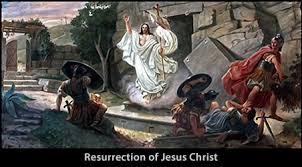
 Christian art has not always followed this clue. Throwing off such restraint, children’s illustrated Bibles often set out for little eyes what the artist thinks they want to see: the moment of resurrection! The problem is especially bad for Christian comic books (to prove this you could consult the world’s greatest scholarly archive of such materials), where the temptation to do a Bang! Pow! Smash! Burst of Light! is palpable.
Christian art has not always followed this clue. Throwing off such restraint, children’s illustrated Bibles often set out for little eyes what the artist thinks they want to see: the moment of resurrection! The problem is especially bad for Christian comic books (to prove this you could consult the world’s greatest scholarly archive of such materials), where the temptation to do a Bang! Pow! Smash! Burst of Light! is palpable.
But the problem is more ancient than Sunday School illustrations. Help yourself to the works of the greatest painters in the western tradition, and what you’ll find is image after image of the resurrection of Jesus that simply go too far: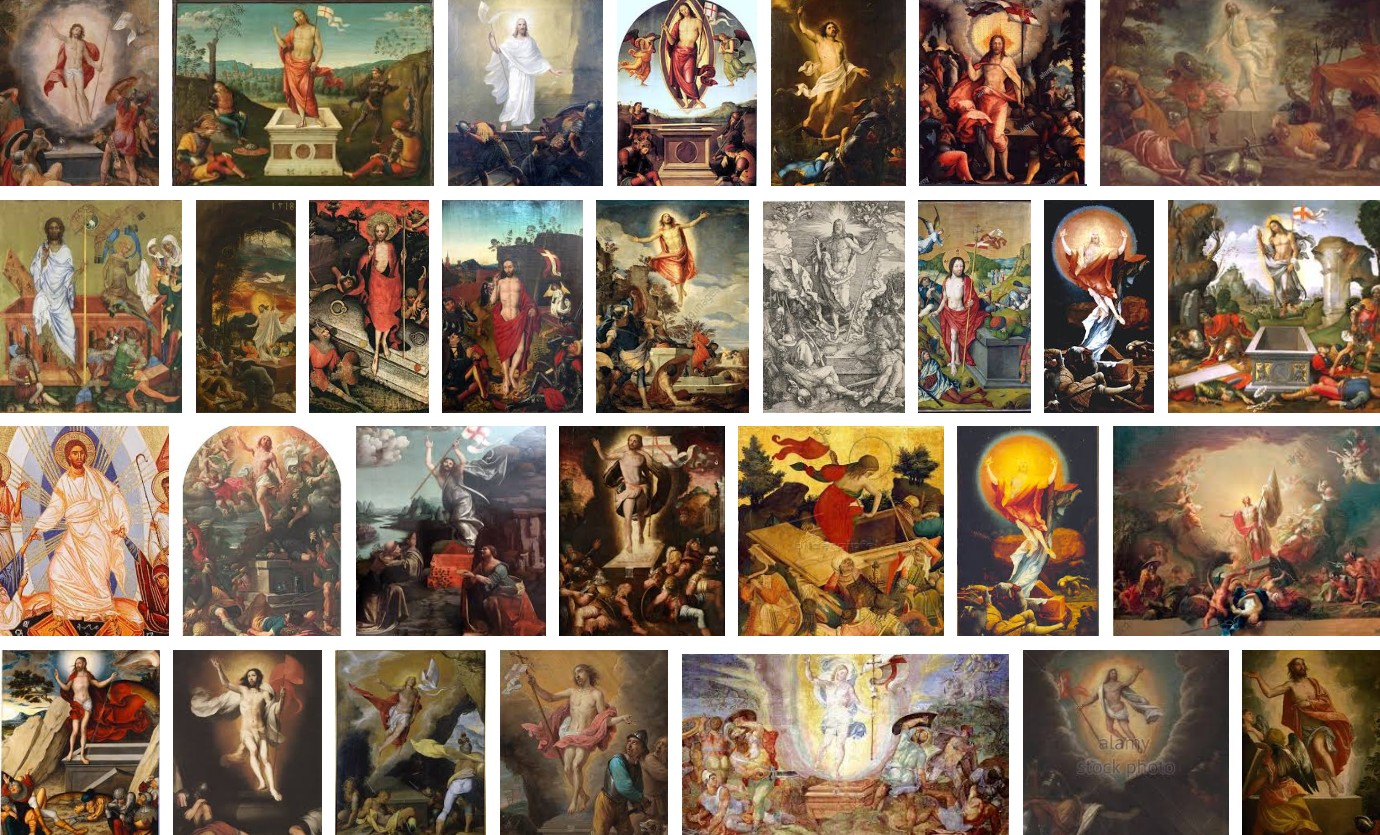
The canons of eastern Christian art forbid direct depiction of the resurrection, but instead of resulting in the kind of restraint we might hope for, the Byzantine iconographic tradition instead gives us the direct visual portrayal of Christ’s descent into hell, where, right before our eyes, he rescues Adam and Eve and the patriarchs. In comparison with some western excesses there may be much to commend this icon of the anastasis (so called), but we can hardly say that it succeeds at averting our eyes from what Scripture does not portray. Where the western conventions show us (as Scripture does not) Jesus bursting from the tomb, the eastern conventions show us (as Scripture does not) a whole other world of divine activity.
I am not (here) trying to lay down the law about what can and cannot be portrayed. What I am saying is that Scripture is wise even in its silences, and that its refusal to narrate the moment of resurrection is intentional.
Even Matthias Grunewald, whose Isenheim Altarpiece makes the crucifixion of Jesus so palpably present to our imaginations, should have stopped painting before he attempted to bring the resurrection before our eyes: 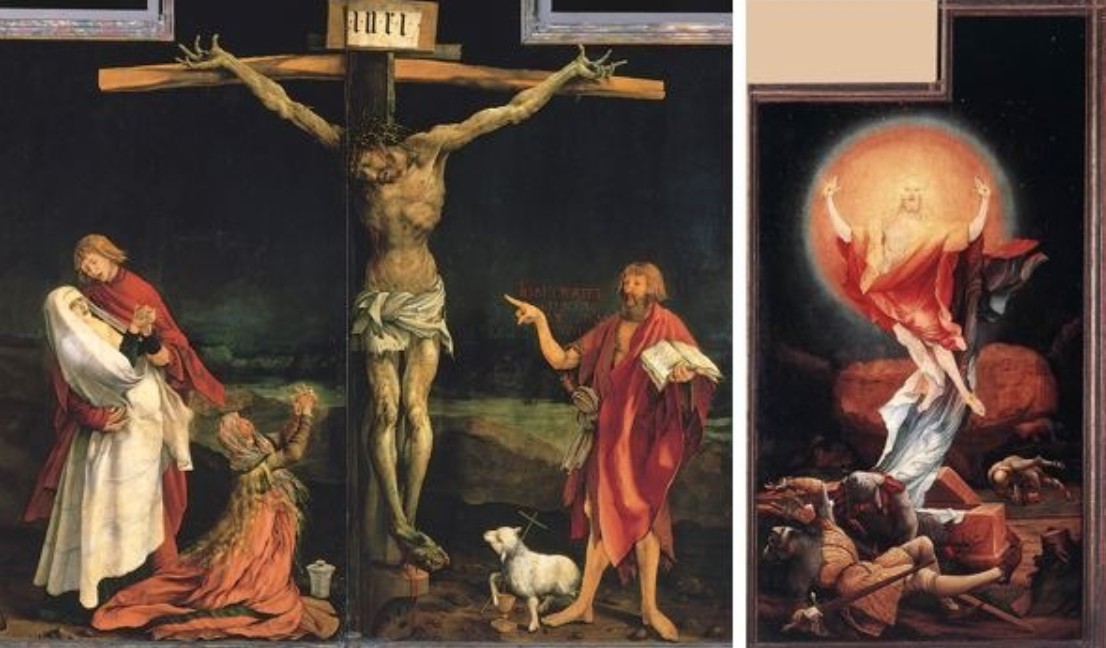
Grunewald’s painting of Christ on the cross is so immediately convincing that it takes most viewers some time to realize that, chronologically speaking, John the Baptist cannot actually be there: he is in the painting as a theological witness, not as an eyewitness. His painting of the resurrection, on the other hand, is so immediately unconvincing that even Christians who firmly believe in the bodily resurrection of Jesus Christ from the dead and are ready to argue for it take one look at this image and begin to have their doubts.
This may be a clue to why the Bible does not directly depict the resurrection of Jesus: Direct depiction makes it difficult to believe. God’s own strategy for making the resurrection known is to give us everything leading up to it, and the changed reality that flows directly from it, but not the moment itself. To put it even more directly: This Jesus who is physically risen and permanently present with us, is the Jesus who commissioned his inspired witnesses, the authors of the gospels, to affirm the reality of his resurrection without depicting it for the church.
Maja Lisa Engelhardt has claimed the focal wall of Calvary Chapel for an image of the resurrection. But her approach to the challenge of depiction is wise and disciplined. What she has depicted is only the empty tomb, but it is an empty tomb that pushes out beyond any framing constraints and takes over the entire wall. Symbolically speaking, it is an empty tomb that transforms everything, since on the plane of the wall surface, absolutely everything is claimed by the golden reality of the resurrection.
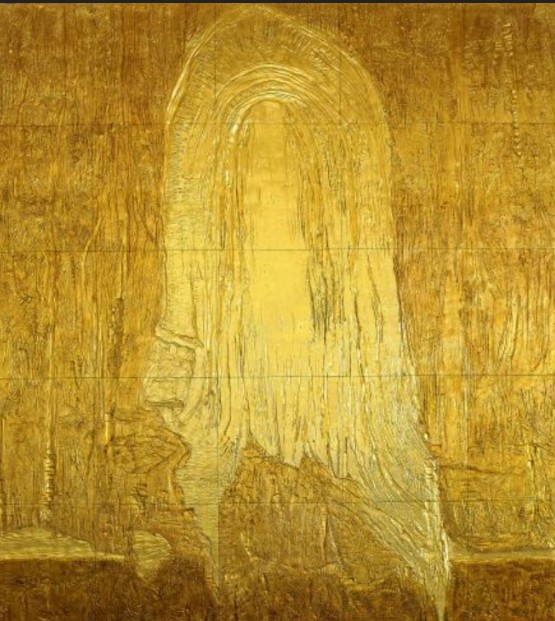 The central image on the resurrection wall is a tall mound; I have been calling it the empty tomb, but not every viewer will see it this way immediately. It may look like a shroud, or even an indistinct face. Some may be able to discern a standing human figure in the midst of the shape. Engelhardt’s stern simplification of form, and abstraction of figures, guarantees that multiple perceptions will shimmer in and out of focus just as the metallic color of gold shimmers between dark and light as the light strikes it differently. And the central figure dominates but does not exhaust the wall. Only about twelve of the 45 panels are given over to the central image. The rest of the wall is some kind of shallow relief sculpture that refuses to coalesce as a landscape but also won’t settle for being the sheer cliff that, materially, it just is. It calls to mind Anselm Kiefer’s wall-sized paintings built up from sculptural materials, but it is not wall-sized; it is wall.
The central image on the resurrection wall is a tall mound; I have been calling it the empty tomb, but not every viewer will see it this way immediately. It may look like a shroud, or even an indistinct face. Some may be able to discern a standing human figure in the midst of the shape. Engelhardt’s stern simplification of form, and abstraction of figures, guarantees that multiple perceptions will shimmer in and out of focus just as the metallic color of gold shimmers between dark and light as the light strikes it differently. And the central figure dominates but does not exhaust the wall. Only about twelve of the 45 panels are given over to the central image. The rest of the wall is some kind of shallow relief sculpture that refuses to coalesce as a landscape but also won’t settle for being the sheer cliff that, materially, it just is. It calls to mind Anselm Kiefer’s wall-sized paintings built up from sculptural materials, but it is not wall-sized; it is wall.
The golden, sculptural surface is covered with a profusion of forms; Engelhardt’s mark-making includes scratches from fingers and nails, trenches, negative spaces left by imprinted objects, thumb and knuckle prints, polished areas, angular wedge-marks, and unctuous blobs. It is hard to tell if they were made by the tools of an artist or a farmer; probably both are here.
And what do these marks on these panels on this wall depict? Burned charcoal timber. I also see machine-planed wood, with both its undulating, organic woodgrain and its precise, saw-cut lines. Keep looking and you see cat-tails; both the kind by the riverbank and the kind on a cat’s hindquarters. There are ferns. Cottage cheese. Bird wings. Grass. The face of a waterfall. Sunbeams and broken glass; curtains and hair; fish scales and fins. Queen Anne’s Lace and String-of-Pearls succulents. Linen. Mudbanks, pine cones, crab claws, and bricks. Sheets of ice. Seed pods. Sponges. I see every kind of hair, from long and smooth to tangled and curly. The baleen of a whale. Many kinds of twigs.
If we assign a letter to each row and a number to each column, we can have articulate discussions about what is where: B7 features cat-tails. C2 is silk or water. D3 has a rhythmic repetition of small forms that are distinct but hard to name. Chapel speakers be warned: If you drift from your subject, my eyes will drift to E8 where all three colors of gold come together in balance. With a shark fin.
There is nowhere in Calvary Chapel to hide from this golden wall. It is arresting if you turn toward it, but even if you turn away from it, the character of the light in the room bears silent witness to what you are trying to ignore. The light from all 32 stained-glass windows is in running dialogue with the light from the wall. You may even be able to hear the gold. The acoustics of the chapel are very different this year, because Brandes and Engelhardt have stripped out the wood-and-burlap ornamentation of the previous scheme. That original 1975 interior had, at its best, a solidity and reverential dignity appropriate for worship and especially for preaching; at its worst it could seem like a holy hunting lodge. And it tended to swallow sound. The new chapel bounces sound off its walls brightly. The room gives every word, spoken or sung, the kind of echo you would expect in a room with a golden back wall.
What are we looking at when we look at Engelhardt’s resurrection wall? It suggests the full range of created form itself. And though Engelhardt could have had all of these shapes radiating outward from the strong, central figure as from a vanishing point or a central explosion, she chose instead to let all of them occupy their own places in the grid of the wall. They are not unaffected by the center, of course: they are golden, and they are here, in the resurrected presence.
I don’t know if Engelhardt was consciously grappling with the problem of depicting the resurrection as she planned and executed this wall. I don’t have any inside knowledge about her intentions or ideas as she worked; what I’m describing is the result and effect of what she has accomplished with this wall. She has brought before our eyes the reality of the resurrection of Jesus without depicting it in an unscripturally straightforward way. This is a solid wall that faith in the resurrection can stick to; a painting of Jesus blasting dramatically out of the tomb would be a wall off of which faith might bounce.
I’ve already said that the resurrection wall follows the lead of the four gospels. If I could say this without fear of misinterpretation (there’s a lot of silly talk abroad these days), I would say that the wall is a visual counterpart to Paul’s theology of the resurrection. In Ephesians, Paul describes the power of God at work “when he raised him from the dead and seated him at his own right hand, far above all…” Notice how Paul slides right over the historical narrative: if you didn’t know better, and didn’t have the gospels as a basis, you might think Jesus went directly from the tomb to the ascension. But Paul’s point is that the resurrection of Christ is already, immediately and in itself, his exaltation and enthronement above all. And Engelhardt’s wall captures that singularity: the resurrection is an event in history –never less than that, we insist at the Biola University with its foundations in the soil of The Fundamentals! But it is also more than that: not one event contained in a larger history, but The Event, The History, The Moment of the eternal Son’s repetition and enactment of his eternal glory at the right hand of the Father in the unity of the Spirit. To depict this undepictable, Engelhardt’s wall does not bring before our eyes the details of an imagined upper world where we can picture these things taking place. She gives us the things of this world, transfigured and transferred so that they witness to the undepictable reality.
To say this more generally: In a primal and fundamental way, Engelhardt’s strategy of depiction is to set forth the abstracted forms of nature in their plenitude, but with the unsubtle hint that they are golden. The wisdom of this approach runs deep, all the way to the foundation of the very possibility of Christian art.
Kierkegaard, to bring up another Dane, said in his Works of Love that “all human language about the spiritual, yes, even the divine language of Holy Scriptures, is essentially transferred or metaphorical language.” It starts with what it has, and asserts that what it has points to something beyond. When God tells us about himself and about spiritual realities in human language built up from human impressions, he is pressing language to function with this power of transfer. “Transferred language,” says Kierkegaard, is “not a brand new language; it is rather the language already at hand. Just as spirit is invisible, so also is its language a secret, and the secret rests precisely in this that it uses the same language as the simple man and the child but uses it as transferred.”
We expect indirect communication from a dialectical wit like Kierkegaard; we do not expect it from a gigantic sculptural wall of gold. But that is what we have on Biola’s campus now. This monumental work of indirect communication is an excellent complement to what I believe is still the largest piece of sacred art on campus, Kent Twitchell‘s photorealist mural The Word. Twitchell’s giant Jesus needs to be interpreted in the context of public, urban art. He has made different decisions and solved different problems with his contribution to the campus. Engelhardt’s resurrection wall joins the conversation with a witness no less eloquent for its indirectness.